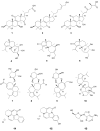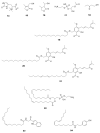Tracing the Path between Mushrooms and Alzheimer's Disease-A Literature Review
- PMID: 37513486
- PMCID: PMC10384108
- DOI: 10.3390/molecules28145614
Tracing the Path between Mushrooms and Alzheimer's Disease-A Literature Review
Abstract
Alzheimer's disease (AD) is well-known among neurodegenerative diseases for the decline of cognitive functions, making overall daily tasks difficult or impossible. The disease prevails as the most common form of dementia and remains without a well-defined etiology. Being considered a disease of multifactorial origin, current targeted treatments have only managed to reduce or control symptoms, and to date, only two drugs are close to being able to halt its progression. For decades, natural compounds produced by living organisms have been at the forefront of research for new therapies. Mushrooms, which are well-known for their nutritional and medicinal properties, have also been studied for their potential use in the treatment of AD. Natural products derived from mushrooms have shown to be beneficial in several AD-related mechanisms, including the inhibition of acetylcholinesterase (AChE) and β-secretase (BACE 1); the prevention of amyloid beta (Aβ) aggregation and neurotoxicity; and the prevention of Tau expression and aggregation, as well as antioxidant and anti-inflammatory potential. Several studies in the literature relate mushrooms to neurodegenerative diseases. However, to the best of our knowledge, there is no publication that summarizes only AD data. In this context, this review aims to link the therapeutic potential of mushrooms to AD by compiling the anti-AD potential of different mushroom extracts or isolated compounds, targeting known AD-related mechanisms.
Keywords: Alzheimer’s disease; mushrooms; natural products; therapy.
Conflict of interest statement
The authors declare no conflict of interest.
Figures



References
-
- Alzheimer Europe . Dementia in Europe Yearbook 2019: Estimating the Prevalence of Dementia in Europe. Alzheimer Europe; Helsinki, Finland: 2019.
Publication types
MeSH terms
Substances
Grants and funding
LinkOut - more resources
Full Text Sources
Medical

